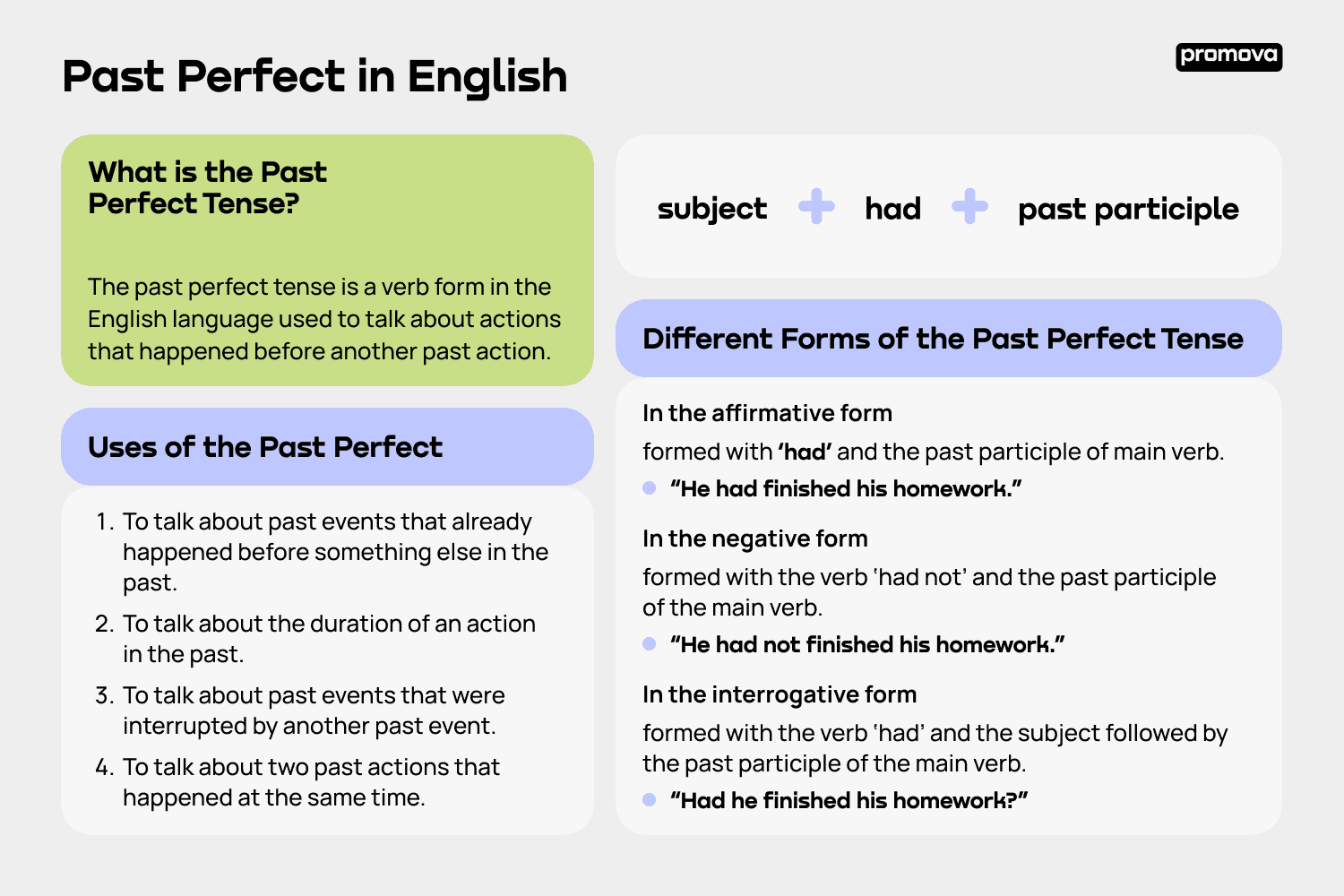Past Perfect in English
Contents
Past perfect, also referred to as the pluperfect, helps us talk about actions related to other actions. In this reference, we will discuss what is the past perfect tense, its uses, different forms, example sentences, and tips for mastering this complex verb tense!
What is the Past Perfect Tense?
The past perfect tense is a verb form in the English language used to talk about actions that happened before another past action. It is formed by using the past form of the verb ‘had’ and the past participle of the main verb. The past perfect tense is used to refer to events that happened in the past before something else in the past.
For example, “She had already finished her homework before her friends arrived.” In this sentence, the past perfect tense is used to indicate that the action of finishing her homework was completed before her friends arrived.
The formula for the past perfect tense looks like this:
Subject + had + past participle of the main verb
For example, “He had finished his homework.”
We also use this tense to explain the duration of actions in the past. For example, “She had been studying for two hours before she stopped.” In this sentence, the past perfect tense is used to indicate that the action of studying had been occurring for two hours before she stopped.
Uses of the Past Perfect
The past perfect tense is useful:
- To talk about past events that already happened before something else in the past.
- To talk about the duration of an action in the past.
- To talk about past events that were interrupted by another past event.
- To talk about two past actions that happened at the same time.
“He had been running for an hour before he had to stop because he was tired.”
In this sentence, the past perfect tense is used to indicate that the action of running was happening for an hour before it was interrupted by the action of him becoming tired.
“She had been cooking dinner while her husband was watching TV.”
In this sentence, the past perfect tense is used to indicate that the action of cooking dinner and the action of watching TV were happening simultaneously in the past.
Note that the past perfect is never used when talking about events that are still happening in the present. For example, “She had been studying for two hours” is correct, but “She has been studying for two hours” is incorrect.
1
Different Forms of the Past Perfect Tense
The past perfect tense can be used in a variety of forms. It can be used in affirmative, negative, and interrogative forms.
- In the affirmative form, it is formed with ‘had’ and the past participle of your main verb. For example, “He had finished his homework.”
- In the negative form, it is formed with the verb ‘had not’ and the past participle of the main verb. For example, “He had not finished his homework.”
- In the interrogative form, it is formed with the verb ‘had’ and the subject followed by the past participle of the main verb. For example, “Had he finished his homework?”

Examples of the Past Perfect Tense
Here are some examples of the past perfect tense in sentences:
- “She had already eaten dinner before her friends arrived.”
- “He had been running for an hour before he had to stop.”
- “She had been studying for two hours before she stopped.”
- “He had been working on the painting for a week before he finished it.”
- “She had been cooking dinner while her husband was watching TV.”
Summary
Soon enough, you will be able to master the past perfect tense. Just remember the formula: had + past participle of the main verb. With this, you can form affirmative, negative and interrogative sentences.
Soon, you'll learn to easily use this tense to talk about all sorts of events that happened in the past. Check out more handy verb tense references below to learn more!
Comments